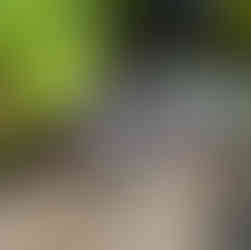Master Gardeners LOVE visiting gardens, and our recent trip to Meghan Pasken’s backyard was a delightful adventure into sustainable gardening techniques. Her garden, a haven of eco-friendly techniques, features a water garden, rain garden and hydroponics system. This visit not only showcased the beauty of these methods, but also provided us with invaluable insights into creating self-sustaining garden ecosystems. Join us as we explore her garden!
Set back from the road down a long driveway, Meghan’s home sits on 2 acres and is surrounded by beautiful hardwoods. Her fenced-in backyard is the perfect playground for her three young children to explore nature. Upon entering, we were immediately captivated by the wattle fence surrounding the herb garden. Made from recycled crepe myrtle stems and limbs, the fence reinforces her theme of recycling and reusing materials.

Approaching the patio area, we encountered a vibrant pollinator garden filled with natives such as Hot Lips Salvia, Rudbeckia, Coneflowers, Yarrow, Rattlesnake Master, Spigelia, Georgia Aster, Mountain Mint, Bee Balm and live mulch, such as Creeping Jenny, Phlox, and Ajuga. Two Coral Bark Japanese maples frame an arbor covered with the native Cross Vine, leading to a rock wall water garden teeming with plants and fish. The soothing sound of bubbling water was a refreshing respite on the hot day.


This water garden was a raised pond with a plastic liner. When the Paskens first purchased the home, the pond resembled green pea soup, due to algae and neglect. Sunlight and excess nitrogen had created a host of problems, prompting Meghan to install an in-ground UV filter. After researching extension publications, watching YouTube videos, and lots of trial and error, she transformed the murky pond into a thriving ecosystem with a variety of plants, frogs and tadpoles, snails, and goldfish. Once the right balance of plants, fish, algae, nitrogen, and microbes was achieved, she was able to disconnect the filter. The water is now clear and being cleaned naturally by the plant's roots. The water is recirculated by a small pump that sends water up to a waterfall that aerates the water. Aeration and water movement is critical for returning oxygen to the water. Water that is not moving can become stagnant with problems such as high water temperature, smelly bacteria and algae growth, and a breeding ground for mosquitoes. Now apparently, it is not about encouraging plants to grow, it is about controlling their spread!


There are three types of plants for a water garden – bog plants (semi aquatic plants that grow in soft wet soil), floating plants, and deep-water plants. Climbing Fig scales the rocks of the pond, while Water Hyacinth, Colocasia, Water Lilies, Papyrus, Horsetail, Parrot Feather, Creeping Jenny, Blue Eyed Grass, Yellow Flag Iris, and Chameleon Plant thrive in the water. Japanese TrapdoorSnails help keep the pond bottom free of algae. Meghan uses a mosquito dunk, which is not harmful to the fish. When we fed the fish, we saw just how many comet goldfish came to the surface. Thepondguy.com or Randy’s Perennials and Water Gardens in Lawrenceville are great resources for questions and plants.
Interesting enough, the overgrowth from the water garden led to her establishing a rain garden. Roof runoff was eroding her beds, and while a rain barrel with a diverter helped, she found that a rain garden was the ideal solution. Using the overgrowth from her water garden, she planted chameleon, ajuga, creeping jenny, Blue eyed grass, and river oats directly into the rain garden, and the plants are thriving. There may be a need later in the summer to supplement the water, but for now it is the perfect solution. UGA’s publication on rain gardens is a great resource for anyone interested in this technique.

This year, Meghan decided to experiment with hydroponics. She purchased a kit from Amazon for around $60. In hindsight, she could have made it herself, but now she has a design to use. Basically, it is a tiered pvc pipe stand with a closed loop circulation system. A small pump pulls the nutrient solution up from a reservoir (bucket) up to the channels every 15 minutes. Then gravity sends the solution through the roots of the plants on each level and then empties back into the bucket. Netting was put over the top, merely to keep the dogs and chickens from drinking the water. The water is changed weekly, and Meghan puts a ½ mosquito dunk in the water to prevent mosquitoes from breeding in the bucket.

To plant, she puts seeds in sponges in the various holes. She is growing lettuce, kale, parsley, and basil. They require morning sun for about 3 to 4 hours. She harvests the leaves from the bottom. Once the plant crowns, she will pull it out and start another seed. A hydroponic system can be put on a covered porch, or even inside during the winter.
The Pasken's ten chickens roam freely, eating slugs and providing endless entertainment for her children, who carry them around like pets. We were all amazed at how soft their feathers were!

Meghan loves teaching about backyard ecosystems and always emphasizes that a garden is about so much more than just pretty plants. What she loves most about her garden is the diversity of living things that make her backyard their home. Her plants are healthier because of the ecosystem she has encouraged. Bird feeders and birdhouses draw in hummingbirds and native songbirds. Bees and butterflies pollinate the plants. Amphibians such as toads, leopard frogs, and tree frogs depend on the pond. Her daughter even found a salamander this week! Reptiles are an important part of the backyard ecosystem here in GA too! Meghan has Green Anoles and Skinks living between the rocks around her pond and black rat snakes that keep rodents in check around her chicken coop.

We learned a lot, dug up a few plants to take home (which is always fun), and left with dreams of our own water gardens, rain gardens, and hydroponic systems. Of course, we now envision a water garden in our Experiential Learning Garden at the Walton County Extension office. Wouldn’t that be cool?




















Meghan you rock! I love every nook & cranny of your beautiful home gardens! I’ve got much to learn:)